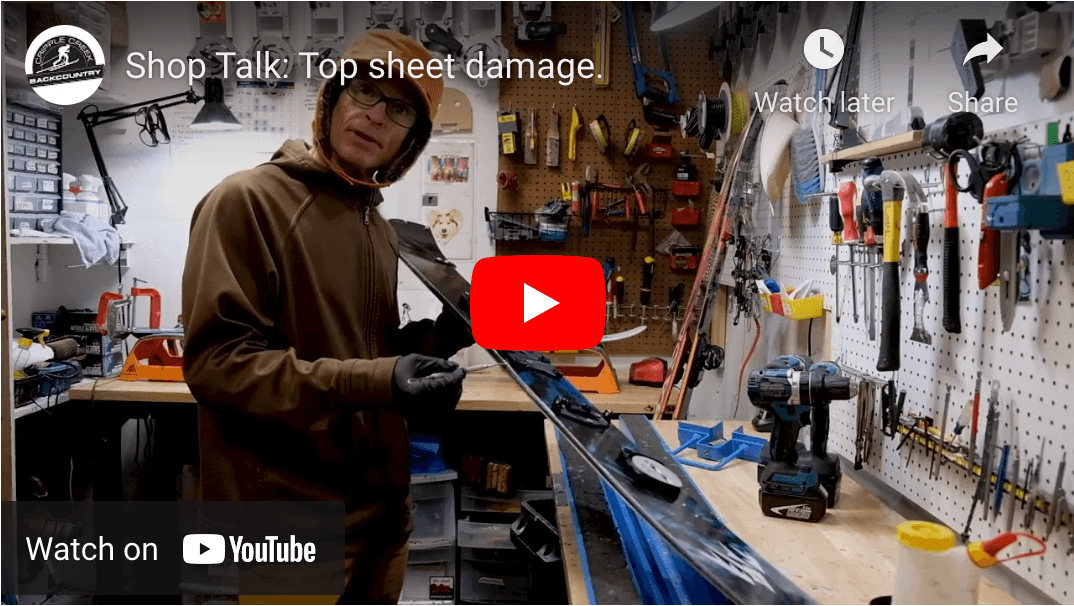Our resident ski and board tech Angus talks about the types of damage that can occur on your board or skis. Getting on top of of small damage prevents water from entering your core and causing more catastrophic failures down the line, so it's important to be proactive!
Materials Needed for Repair:
- Superglue or epoxy
- Toothpick or small metal pick
- Fine grit sandpaper (300-1000 grit)
- C-clamps (for clamping delaminations)
- Metal or plastic wax scrappers (useful with the use of C-clamps for repairing delaminations)
- Razor blade
Repairing basic top sheet damage
Goal: To seal out moisture from your ski or board core and prevent further damage
The Problem: Repairing a top sheet is a simple procedure that takes only five minutes, but can save you hours of headache down the road. As the top sheet of you ski or board goes through normal ware, it is common for the top sheet to chip and expose the fiberglass and wood beneath.
The problem is that the core materials in ski construction are often porous and absorb moisture. In turn, moisture in the core causes expansion of materials and causes delaminations between the core and base and/or the core and sidewall.
The Fix: If you find damage to your top sheet during inspection, you should seal the damage with superglue or (even better) epoxy. For this repair, a quickset epoxy will work just fine.
To start, you need to prep the damaged area for repair. Start by taking a razor blade and cutting away any pieces of top sheet that are flaking off or still attached but damaged. Alternatively, if you have a large section of top sheet that is still hanging onto the ski, you can glue and clamp the top sheet back to the core. Once any excess material is removed, sand the damaged area starting with rougher grits (300) and working your way up to finer grits (1000). Make sure to clean the damaged area once sanded (a damp paper towel works just fine).
Ad a thin layer of glue or epoxy to the damaged area, making sure to cover all exposed material. Unless you are clamping a piece of damaged top sheet back, there is no need to use clamps as our primary goal is sealing out moisture. Once the glue has set, use fine grit sandpaper to smooth out the glue and ensure there are no rough edges on the repair that could catch when skiing.
Repairing Delaminations
Goal: Prevent further spreading of delaminations and ensure the structural integrity of your skis or board
The Problem: Delaminations along the edge and sidewall are a common failure point on skis. A small delam can easily be fixed and will help prevent further structural failures.
The Fix: The process for fixing delams is similar to that of top sheet repair, but with the added step of clamping the ski while the glue dries. For these repairs, we typically like to use a slower setting epoxy to ensure adequate work time (note: superglue won't cut it for structural repairs to skis and boards).
Start by prepping your repair area. Remove any pieces of top sheet that can't be glued and ensure there is no debris that has worked itself into the delam. Once the area is prepped add epoxy into the delam. Your goal is to have the epoxy throughout the affected area. A toothpick is useful for pushing epoxy deep into the delamination, and it is also useful to use gravity to let the epoxy work itself into the base. We also like to mask off the damaged area with masking tape to make the cleanup easier and prevent epoxy from bonding to the base.
Clamping the ski is the most challenging part of the process, and it is useful to dry fit camps before the delam is glued. C-clamps are ideal, and we also like to use metal scrapers to sandwich the delam and disperse the pressure from the clamps. If the delam is a simple sidewall detaching from the edge as shown in the video, clamping the base and top sheet together is usually sufficient. For more complex delams, you may also need to add a clamp from edge to edge to if the edge is detaching from the base side.
Once your repair has set up for 24 hours, remove the clamps and clean up excess epoxy with a razor blade and fine grit sandpaper.




